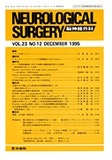Japanese
English
- 有料閲覧
- Abstract 文献概要
- 1ページ目 Look Inside
I.はじめに
Twist drill craniostomyは1930年代にCone等により考案され15),腫瘍と膿瘍の鑑別のための試験穿刺法,外傷性血腫の診断・緊急処置技術などとして用いられていた2,4).論文上の報告は1966年のRand16)等のものが最初で,1977年Tabaddor17)等が本法の慢性硬膜下血腫の治療における有用性を報告して以来,本法に関する報告の殆どが慢性硬膜下血腫の治療に関連したものである2-4)本邦での報告は北見等9)らの慢性硬膜下血腫の治療に有用との報告のみで,この技術は広く普及するには至っていない.われわれは,脳腫瘍患者に対する定位脳手術に本法を用い,通常のburr hole craniostomyとの比較検討を行った.その結果,本法は簡便,迅速な穿頭法で安全性にも問題なく,種々の目的の定位脳手術に広範に広用可能と考えられたので,その方法を中心に報告する.
A twist drill craniostomy is a rapid and relatively simple technique for perforating the skull in order to gain access to the epidural and subdural spaces and the brain.
Fifty-eight patients underwent 173 twist drill cranios-tomies in the stereotactic procedures for the diagnosis and the treatment of brain tumors (brain tumor biopsy, implanting radioactive sources and placement of the catheters for navigation surgery) from September, 1992, through to May, 1995, at our institute. The technique was compared with standard burr hole craniostomy used in 42 patients with brain tumor. In the twist drill craniostomy, the scalp was pene-trated directly by hand twist drill (2.7mm in diameter) and scalp bleeding was able to be be controlled by in-jecting local anesthetic with epinephrine subcutaneous-ly. The safety stop on the drill was set in advance based on the expected thickness of the skull at its penetration point to provide control of penetration depth as it passed through the skull hole and dura. A hole in the skull was made as the drill was advanced until a change in resistance indicated that the inner table of the skull had been penetrated and the dura lacerated. The cannula with stylet was then inserted through the guide tube to assure the penetration of the skull and dura. As the cannula penetrated the dura, a loss of resistance was noted as it proceeded through the dura toward the pial surface. The time needed in this procedure was less than 3 minutes. Associated with this procedure, there were no complications such as bleeding, or infection in 173 twist drill craniostomies in the 58 patients.
Our experience with this procedure proved it to be simple, efficient, safe and superior to conventional burr hole craniostomy.

Copyright © 1995, Igaku-Shoin Ltd. All rights reserved.


